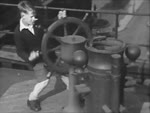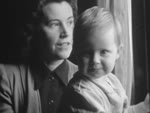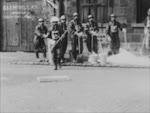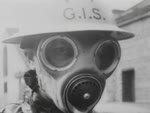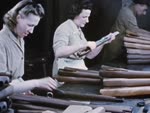CIVIL DEFENCE IN GLASGOW
Full length video
Please read Understanding catalogue records for help interpreting this information and Using footage for more information about accessing this film.
Title: CIVIL DEFENCE IN GLASGOW
Reference number: 0156
Date: 1942
Director: [filmed by B.H. Humble]
Sound: silent
Original format: 16mm
Colour: bwcol
Fiction: non-fiction
Running time: 57 mins
Description:
Made in 1942 to demonstrate civil defence procedures and the organisations involved.
Series of five surviving out of six films made in 1942 to demonstrate civil defence procedures of all kinds and the organisations involved. See also ref. 0157 ANTI-GAS PRECAUTIONS IN GLASGOW.
Humble papers deposited in National Library of Scotland. Further information can be found at https://manuscripts.nls.uk/agents/57836?agent_type=agent_person [last accessed 26/08/2021]
See additional information file held at National Library of Scotland Moving Image Archive. See also biography "The Voice of the Hills: The Story of Ben Humble" by Roy M. Humble.
Shotlist:
REEL I (Part 2: When the Sirens Sound)
[b/w] No credits. Animated illustration of the stages of setting up fire-fighting action (.37) the St. James Fire Service wagon in action as it dashes to the scene of a fire. National Fire Service emergency operations and how they work from headquarters (3.35) When telephone communications break down, cyclists are on hand to take messages. 2,000 boys are trained and ready (4.08) animated sequence of events (4.25) Police. Role of same in fire-fighting and air raid precautions. P.J. Sillitoe at work showing organisation chart and services provided (5.34)
REEL II (Part 3: Reserve Service)
[b/w] No credits. Mr. T. Somers, City Engineer, demonstrates distribution of rescue party depots on map (.35) Rescue party training. Hypothetical air raid (6.24) Shelters, communal and domestic, illustrated by diagram and on streets in George Square and Glasgow Green and city parks moving onto tenements with shots of the blast walls ouside the tenement buildings(8.41)
REEL III (Part 4: First Aid Service)
[b/w] No credits. Medical officer of health, Sir Alexander McGregor, and staff at First Aid party depots in Picadilly House. Team moves off to cope with a disaster (2.02) Whiteinch First Aid Post, nurses, patients (2.45) Church Street First Aid Post. enactment of roof top drama (4.02) Contribution of Casualty Service during quiet periods in vaccination and diphtheria immunisation scheme (6.08) Ambulances (6.18) [col] Glasgow branch of St. Andrew's Ambulance Association, vehicle and its comfy, well-equipped interior (7.44) [b/w] raising money for more vehicles by public subscription. Local officials raise cash for 50 vehicles. Presentation of new vehicles to several branches of St. Andrew's Ambulance Association (9.40) First colour film made by the Casualty Service of First Aid party in action. Staged disaster in Knightswood area of Glasgow and the procedures adopted (10.24)
REEL IV (Part 5: Anti-Gas Procedures)
[b/w] No credits. One of the frequent exhibitions on gas and its effects to bring home the dangers to the public (2.47) gas vans always available for testing masks (3.29) de-contamination of civilians at a Gas Cleansing Station (5.30) mobile gas cleansing units. Identification of war gases by City Analyst's department. Personnel of 90 work in gas identification. Laboratory tests are carried out on foodstuffs for contamination (9.25)
REEL V (Part 6: Decontamination)
[b/w] No credits. Streets, vehicles and clothes all have to be decontaminated after a gas attack. Streets are treated with chemical neutralisers (1.32) commercial vehicles daubed with leech paste (3.12) public baths prepared to decontaminate clothing (5.50) Emergency Relief Organisations Hostels, rest centres, canteens and temporary shelter for homeless all available. Mobile canteens bring food to refugees passing through the city. Many Polish children housed in hostels. Pavilions in public parks are converted to emergency kitchens (9.20)
REEL VI (Part 7: Co-ordination and Control)
Credits. Co-ordination of the various services is in the hands of - shot of "Corporation of Glasgow" notepaper (Charles Fraser, Co-ordinating Officer) (.18) Mr. Fraser at his desk (.28) He meets representatives of the services regularly. In office with two CD officers (.40) - and arranges inspections and joint exercises (.51) memo - "Annual inspection of Civil Defence Services in North-West Area, Firhill Park". Shots of Firhill Park with assembled CD Units. gvs of the inspection by officials and march past of various units (3.52) Civil Defence Day. Inspection by the Duke and Duchess of Gloucester. Lord Provost of Glasgow, Duke and Duchess cross from the City Chambers to Cenotaph in George Square. Shots of march past of CD Units (4.30) Civil Defence Exercises. First Aid Post officers and ARP ambulance units attend scene of disaster. The "victims" are assisted from buildings (6.25) The Civil Controller looks after the entire organisation. Diagram of responsibilities (6.39) shots of Town Clerk, Controller (William Kerr), ARP circulars and codes of practice, Deputy ARP Controller and another Deputy Controller (Gavin McCarthur) (8.20) Meeting of the Lord Provost and the Emergency Committee. Shots around table, those present including P.J. Dollan and Jean Roberts (10.55) The End (10.58)

